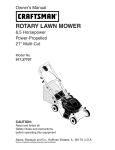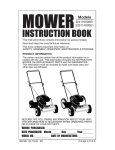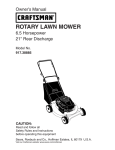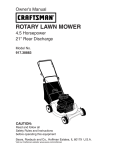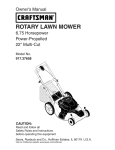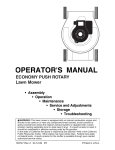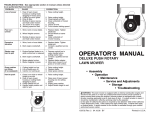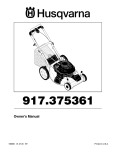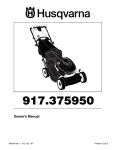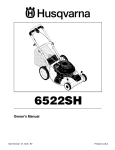Download Craftsman 917.38765 Owner`s manual
Transcript
Owner’s Manual ROTARY LAWN MOWER 4.5 Horsepower 22" Side Discharge Model No. 917.38765 CAUTION: Read and follow all Safety Rules and Instructions before operating this equipment Sears, Roebuck and Co., Hoffman Estates, IL 60179 U.S.A. Visit our Craftsman website: www.sears.com/craftsman TABLE OF CONTENTS Warranty ...................................................2 Safety Rules ..........................................2-4 Product Specifications ..............................4 Assembly / Pre-Operation ........................6 Operation.............................................7-10 Maintenance Schedule ...........................10 Maintenance ......................................10-13 Ser vice and Adjustments...................13-14 Storage ..............................................14-15 Troubleshooting .................................15-16 Sears Service .......................... Back Cover WARRANTY LIMITED TWO YEAR WARRANTY ON CRAFTSMAN POWER MOWER For two years from date of purchase, when this Craftsman Lawn Mower is maintained, lubricated, and tuned up according to the operating and maintenance instructions in the owner’s manual, Sears will repair free of charge any defect in material or workmanship. If this Craftsman Lawn Mower is used for commercial or rental purposes, this warranty applies for only 90 days from the date of purchase. This Warranty does not cover: • Expendable items which become worn during normal use, such as rotary mower blades, blade adapters, belts, air cleaners and spark plug. • Repairs necessary because of operator abuse or negligence, including bent crankshafts and the failure to maintain the equipment according to the instructions contained in the owner’s manual. Warranty service is available by returning the Craftsman power mower to the nearest Sears Parts & Repair Center in the United States. This warranty applies only while this product is used in the United States. This Warranty gives you specific legal rights, and you may also have other rights which vary from state to state. Sears, Roebuck And Co., D/817 WA, Hoffman Estates, Il 60179 SAFETY RULES IMPORTANT: This cutting machine is capable of amputating hands and feet and throwing objects. Failure to observe the following safety instructions could result in serious injury or death. WARNING: Battery posts, terminals and related accessories contain lead and lead compounds, chemicals known to the State of California to cause cancer and birth defects or other reproductive harm. Wash hands after handling. Look for this symbol to point out impor tant safety precautions. It means CAUTION!!! BECOME ALERT!!! YOUR SAFETY IS INVOLVED. WARNING: In order to prevent accidental starting when setting up, transporting, adjusting or making repairs, always disconnect spark plug wire from spark plug and place wire where it cannot contact plug. WARNING: Engine exhaust, some of its constituents, and certain vehicle components contain or emit chemicals known to the State of California to cause cancer and birth defects or other reproductive harm. CAUTION: Muffler and other engine parts become extremely hot during operation and remain hot after engine has stopped. To avoid severe burns on contact, stay away from these areas. 2 • Always wear safety goggles or safety glasses with side shields when operating mower. I. GENERAL OPERATION • Read, understand, and follow all instructions on the machine and in the manual(s) before starting. Be thoroughly familiar with the controls and the proper use of the machine before starting. • Do not put hands or feet near or under rotating parts. Keep clear of the discharge opening at all times. • Only allow responsible individuals, who are familiar with the instructions, to operate the machine. • Clear the area of objects such as rocks, toys, wire, bones, sticks, etc., which could be picked up and thrown by blade. • Be sure the area is clear of other people before mowing. Stop machine if anyone enters the area. • Do not operate the mower when barefoot or wearing open sandals. Always wear substantial foot wear. • Do not pull mower backwards unless absolutely necessary. Always look down and behind before and while moving backwards. • Never direct discharged material toward anyone. Avoid discharging material against a wall or obstruction. Material may richochet back toward the operator. Stop the blade when crossing gravel surfaces. • Do not operate the mower without proper guards, plates, grass catcher or other safety protective devices in place. • See manufacturer’s instructions for proper operation and installation of accessories. Only use accessories approved by the manufacturer. • Stop the blade(s) when crossing gravel drives, walks, or roads. • Stop the engine (motor) whenever you leave the equipment, before cleaning the mower or unclogging the chute. • Shut the engine (motor) off and wait until the blade comes to complete stop before removing grass catcher. • Mow only in daylight or good artificial light. • Do not operate the machine while under the influence of alcohol or drugs. • Never operate machine in wet grass. Always be sure of your footing: keep a firm hold on the handle; walk, never run. • Disengage the self-propelled mechanism or drive clutch on mowers so equipped before starting the engine. • If the equipment should start to vibrate abnormally, stop the engine (motor) and check immediately for the cause. Vibration is generally a warning of trouble. II. SLOPE OPERATION Slopes are a major factor related to slip & fall accidents which can result in severe injury. All slopes require extra caution. If you feel uneasy on a slope, do not mow it. DO: • Mow across the face of slopes: never up and down. Exercise extreme caution when changing direction on slopes. • Remove obstacles such as rocks, tree limbs, etc. • Watch for holes, ruts, or bumps. Tall grass can hide obstacles. DO NOT: • Do not trim near drop-offs, ditches or embankments. The operator could lose footing or balance. • Do not trim excessively steep slopes. • Do not mow on wet grass. Reduced footing could cause slipping. III. CHILDREN Tragic accidents can occur if the operator is not alert to the presence of children. Children are often attracted to the machine and the mowing activity. Never assume that children will remain where you last saw them. • Keep children out of the trimming area and under the watchful care of another responsible adult. • Be alert and turn machine off if children enter the area. • Before and while walking backwards, look behind and down for small children. • Never allow children to operate the machine. • Use extra care when approaching blind corners, shrubs, trees, or other objects that may obscure vision. IV. SAFE HANDLING OF GASOLINE Use extreme care in handling gasoline. Gasoline is extremely flammable and the vapors are explosive. • Extinguish all cigarettes, cigars, pipes and other sources of ignition. • Use only an approved container. • Never remove gas cap or add fuel with the engine running. Allow engine to cool before refueling. • Never refuel the machine indoors. • Never store the machine or fuel container where there is an open flame, spark or pilot light such as a water heater or on other appliances. 3 • Never fill containers inside a vehicle, on a truck or trailer bed with a plastic liner. Always place containers on the ground away from your vehicle before filling. • Remove gas-powered equipment from the truck or trailer and refuel it on the ground. If this is not possible, then refuel such equipment with a portable container, rather than from a gasoline dispenser nozzle. • Keep the nozzle in contact with the rim of the fuel tank or container opening at all times until fueling is complete. Do not use a nozzle lock-open device. • If fuel is spilled on clothing, change clothing immediately. • Never overfill fuel tank. Replace gas cap and tighten securely. • Keep nuts and bolts, especially blade attachment bolts, tight and keep equipment in good condition. • Never tamper with safety devices. Check their proper operation regularly. • Keep machine free of grass, leaves, or other debris build-up. Clean oil or fuel spillage. Allow machine to cool before storing. • Stop and inspect the equipment if you strike an object. Repair, if necessary, before restarting. • Never attempt to make wheel height adjustments while the engine is running. • Grass catcher components are subject to wear, damage, and deterioration, which could expose moving parts or allow objects to be thrown. Frequently check components and replace with manufacturer’s recommended parts, when necessary. • Mower blades are sharp and can cut. Wrap the blade(s) or wear gloves, and use extra caution when ser vicing them. • Do not change the engine governor setting or overspeed the engine. • Maintain or replace safety and instruction labels, as necessary. V. GENERAL SERVICE • Never run a machine inside a closed area. • Never make adjustments or repairs with the engine (motor) running. Disconnect the spark plug wire, and keep the wire away from the plug to prevent accidental starting. WARNING: This lawn mower is equipped with an internal combustion engine and should not be used on or near any unimproved forest-covered, brush-covered or grass-covered land unless the engine’s exhaust system is equipped with a spark arrester meeting applicable local or state laws (if any). If a spark arrester is used, it should be maintained in effective working order by the operator. In the state of California the above is required by law (Section 4442 of the California Public Resources Code). Other states may have similar laws. Federal laws apply on federal lands. A spark arrester for the muffler is available through your nearest Sears Parts & Repair Center (See the REPAIR PARTS section of this manual). PRODUCT SPECIFICATIONS Serial Number: Date of Purchase: Gasoline Capacity / Type: 1.0 Quart (Unleaded Regular) Oil Type (API SG–SL): SAE 30 (above 32°F); SAE 5W-30 (below 32°F) Oil Capacity: 20 Ounces Spark Plug (Gap: .030") Champion RJ19LM or J19LM Blade Bolt Torque: 35-40 ft. lbs. • The model and serial numbers will be found on a decal on the rear of the lawn mower housing. Record both serial number and date of purchase in space provided above. 4 Repair Protection Agreements Congratulations on making a smart purchase. Your new Craftsman® product is designed and manufactured for years of dependable operation. But like all products, it may require repair from time to time. That’s when having a Repair Protection Agreement can save you money and aggravation. • Fast help by phone – phone support from a Sears technician on products requiring in-home repair, plus convenient repair scheduling. Once you purchase the Agreement, a simple phone call is all that it takes for you to schedule service. You can call anytime day or night, or schedule a service appointment online. Sears has over 12,000 professional repair specialists, who have access to over 4.5 million quality parts and accessories. That’s the kind of professionalism you can count on to help prolong the life of your new purchase for years to come. Purchase your Repair Protection Agreement today! Some limitations and exclusions apply. For prices and additional information call 1-800-827-6655. Purchase a Repair Protection Agreement now and protect yourself from unexpected hassle and expense. Here’s what’s included in the Agreement: • Expert service by our 12,000 profesional repair specialists. • Unlimited service and no charge for parts and labor on all covered repairs. • Product replacement if your covered product can’t be fixed. • Discount of 10% from regular price of service and service-related parts not covered by the agreement; also, 10% off regular price of preventive maintenance check. Sears Installation Service For Sears professional installation of home appliances, garage door openers, water heaters, and other major home items, in the U.S.A. call 1-800-4-MY-HOME®. ACCESSORIES These accessories were available when this lawn mower was produced. They are not shipped with your mower. They are also available at most Sears retail outlets and service centers. Some of these accessories may not apply to your lawn mower. 5 ASSEMBLY / PRE-OPERATION Read these instructions and this manual in its entirety before you attempt to assemble or operate your new lawn mower. IMPORTANT: This lawn mower is shipped WITHOUT OIL OR GASOLINE in the engine. Your new lawn mower has been assembled at the factory with the exception of those parts left unassembled for shipping purposes. To ensure safe and proper operation of your lawn mower, all parts and hardware you assemble must be tightened securely. Use the correct tools as necessary to ensure proper tightness. All parts such as nuts, washers, bolts, etc., necessary to complete the assembly have been placed in the parts bag. HOW TO SET UP YOUR MOWER TO UNFOLD HANDLE IMPORTANT: Unfold handle carefully so as not to pinch or damage control cables. 1. Raise handles until lower handle section locks into place in mowing position. 2. Remove protective padding, raise upper handle section into place on lower handle and tighten both handle knobs. 3. Remove handle padding holding operator presence control bar to upper handle. Your lawn mower handle can be adjusted for your mowing comfort. Refer to “ADJUST HANDLE” in the Service and Adjustments section of this manual. Operator presence control bar TO REMOVE MOWER FROM CARTON MOWING POSITION LIFT UP 1. Remove loose parts included with mower. 2. Cut down two end corners of carton and lay end panel down flat. 3. Remove all packing materials except padding between upper and lower handle and padding holding operator presence control bar to upper handle. 4. Roll lawn mower out of carton and check carton thoroughly for additional loose parts. LIFT UP Upper handle Handle knob Lower handle TO INSTALL ATTACHMENTS Your lawn mower was shipped ready to be used as a mulcher. To convert to bagging or discharging, see “TO CONVERT MOWER” in the Operation section of this manual. 6 OPERATION KNOW YOUR LAWN MOWER READ THIS OWNER'S MANUAL AND ALL SAFETY RULES BEFORE OPERATING YOUR LAWN MOWER. Compare the illustrations with your lawn mower to familiarize yourself with the location of various controls and adjustments. Save this manual for future reference. These symbols may appear on your lawn mower or in literature supplied with the product. Learn and understand their meaning. Operator presence control bar Starter handle Handle knob Engine oil cap with dipstick Air filter Muffler Gasoline filler cap Wheel adjuster (on each wheel) Discharge guard Primer Housing Spark plug IMPORTANT: This lawn mower is shipped WITHOUT OIL OR GASOLINE in the engine. MEETS CPSC SAFETY REQUIREMENTS Sears rotary walk-behind power lawn mowers conform to the safety standards of the American National Standards Institute and the U.S. Consumer Product Safety Commission. The blade turns when the engine is running. Operator presence control bar – must Primer – pumps additional fuel from the be held down to the handle to start the carburetor to the cylinder for use when engine. Release to stop the engine. starting a cold engine. Starter handle – used for starting engine. 7 The operation of any lawn mower can result in foreign objects thrown into the eyes, which can result in severe eye damage. Always wear safety glasses or eye shields while operating your lawn mower or performing any adjustments or repairs. We recommend a standard safety glasses or wide vision safety mask worn over spectacles. CAUTION: Do not run your lawn mower without discharge guard, approved grass catcher or mulcher plate in place. Hinge rod Discharge guard HOW TO USE YOUR LAWN MOWER ENGINE SPEED The engine speed was set at the factory for optimum performance. It is not adjustable. ENGINE ZONE CONTROL CAUTION: Federal regulations require an engine control to be installed on this lawn mower in order to minimize the risk of blade contact injury. Do not under any circumstances attempt to defeat the function of the operator control. The blade turns when the engine is running. • Your lawn mower is equipped with an operator presence control bar which requires the operator to be positioned behind the lawn mower handle to start and operate the lawn mower. TO ADJUST CUTTING HEIGHT Raise wheels for low cut and lower wheels for high cut, adjust cutting height to suit your requirements. Medium position is best for most lawns. • To change cutting height, squeeze adjuster lever toward wheel. Move wheel up or down to suit your requirements. Be sure all wheels are in the same setting. NOTE: Adjuster is properly positioned when plate tab inserts into hole in lever. Also, 9position adjusters (if so equipped) allow lever to be positioned between the plate tabs. LEVER BACKWARD TO LOWER MOWER Lever Plate tab LEVER FORWARD TO RAISE MOWER TO CONVERT MOWER Your mower is shipped ready to be used as a mulcher.To convert to bagging or discharging: • Lift discharge guard and remove mulcher plate. • Mower can now be used for side discharge or optional grass catcher can be attached. • To return to mulching operation, simply reinstall mulcher plate as shown. 8 Housing opening Hooks Mulcher plate Tab BEFORE STARTING ENGINE ADD OIL Your lawnmower is shipped without oil in the engine. For type and grade of oil to use, see “ENGINE” in the Maintenance section of this manual. CAUTION: DO NOT overfill engine with oil, or it will smoke heavily from the muffler on startup. 1. Be sure lawnmower is level. 2. Remove oil dipstick from oil fill spout. 3. You receive a container of oil with the unit. Slowly pour the entire container down the oil fill spout into the engine. NOTE: Initial oil fill requires only 18 oz. due to residual oil in engine from the manufacturers 100% quality testing. When changing oil you may need 20 oz. 4. Insert and tighten dipstick. IMPORTANT: • Check oil level before each use. Add oil if needed. Fill to full line on dipstick. • Change the oil after every 25 hours of operation or each season. You may need to change the oil more often under dusty, dirty conditions. See “TO CHANGE ENGINE OIL” in the Maintenance section of this manual. ADD GASOLINE • Fill fuel tank to bottom of tank filler neck. Do not overfill. Use fresh, clean, regular unleaded gasoline with a minimum of 87 octane. Do not mix oil with gasoline. Purchase fuel in quantities that can be used within 30 days to assure fuel freshness. CAUTION: Wipe off any spilled oil or fuel. Do not store, spill or use gasoline near an open flame. MOWING TIPS CAUTION: Alcohol blended fuels (called gasohol or using ethanol or methanol) can attract moisture which leads to separation and formation of acids during storage. Acidic gas can damage the fuel system of an engine while in storage. To avoid engine problems, the fuel system should be emptied before storage of 30 days or longer. Empty the gas tank, start the engine and let it run until the fuel lines and carburetor are empty. Use fresh fuel next season. See Storage Instructions for additional information. Never use engine or carburetor cleaner products in the fuel tank or permanent damage may occur. Gasoline filler cap CAUTION: Do not use de-thatcher blade attachments on your mower. Such attachments are hazardous, will damage your mower and could void your warranty. • Under certain conditions, such as very tall grass, it may be necessary to raise the height of cut to reduce pushing effort and to keep from overloading the engine and leaving clumps of grass clippings. It may also be necessary to reduce ground speed and/or run the lawn mower over the area a second time. • For extremely heavy cutting, reduce the width of cut by overlapping previously cut path and mow slowly. • For better grass bagging and most cutting conditions, the engine speed should be set in the FAST position. • For side discharge lawn mowers, cutting in a counter-clockwise direction, starting at the outside of the area to be cut, spreads grass clippings more evenly and puts less load on the engine. To keep clippings off of walkways, flower beds, etc., make the first cuts in a clockwise direction. • Pores in cloth grass catchers can become filled with dirt and dust with use and catchers will collect less grass. To prevent this, regularly hose catcher off with water and let dry before using. • Keep top of engine around starter clear and clean of grass clippings and chaff. This will help engine air flow and extend engine life. Engine oil cap Primer TO STOP ENGINE • To stop engine, release operator presence control bar. TO START ENGINE NOTE: Due to protective coatings on the engine, a small amount of smoke may be present during the initial use of the product and should be considered normal. 1. To start a cold engine, push primer three (3) times before trying to start. Use a firm push. This step is not usually necessary when starting an engine which has already run for a few minutes. 2. Hold operator presence control bar down to the handle and pull starter handle quickly. Do not allow starter rope to snap back. NOTE: In cooler weather it may be necessary to repeat priming steps. In warmer weather over priming may cause flooding and engine will not start. If you do flood engine, wait a few minutes before attempting to start and do not repeat priming steps. MULCHING MOWING TIPS IMPORTANT: For best performance, keep mower housing free of built-up grass and trash. See “CLEANING” in the Maintenance section of this manual. • The special mulching blade will recut the grass clippings many times and reduce them in size so that as they fall onto the lawn they will disperse into the grass and not be noticed. Also, the mulched grass will biodegrade quickly to provide nutrients for the lawn. Always mulch with your highest engine (blade) speed as this will provide the best recutting action of the blades. • Avoid cutting your lawn when it is wet. Wet grass tends to form clumps and interferes with the mulching action. The best time to mow your lawn is the early afternoon. At this time the grass has dried, yet the newly cut area will not be exposed to direct sunlight. 9 • For best results, adjust the lawn mower cutting height so that the lawn mower cuts off only the top one-third of the grass blades. If the lawn is overgrown it will be necessary to raise the height of cut to reduce pushing effort and to keep from overloading the engine and leaving clumps of mulched grass. For extremely heavy grass, reduce your width of cut by overlapping previously cut path and mow slowly. MAX 1/3 • Certain types of grass and grass conditions may require that an area be mulched a second time to completely hide the clippings. When doing a second cut, mow across (perpendicular) to the first cut path. • Change your cutting pattern from week to week. Mow north to south one week then change to east to west the next week. This will help prevent matting and graining of the lawn. MAINTENANCE BEFORE EACH USE AFTER EACH USE EVERY 10 HOURS EVERY 25 HOURS OR SEASON EVERY 100 HOURS BEFORE STORAGE Check for Loose Fasteners Clean / Inspect Grass Catcher * Check Tires Check Drive Wheels *** Clean Lawn Mower **** Clean under Drive Cover *** Check Drive Belt / Pulleys *** Check / Sharpen / Replace Blade Lubrication Clean and Recharge Battery ** Check Engine Oil level Change Engine Oil Clean Air Filter Inspect Muffler Replace Spark Plug Replace Air Filter Paper Cartridge Empty fuel system or add Stabilizer * (if so equipped) ** Electric-Start mowers *** Power-Propelled mowers a scraper **** Use to clean under deck 1 - Change more often if operating under a heavy load or in high outdoor temperatures. 2 - Service more often if operating in dirty or dusty conditions. 3 - Replace blades more often when mowing in sandy soil. 4 - Charge 48 hours at end of season. 5 - And after each 5 hours of use. GENERAL RECOMMENDATIONS The warranty on this lawn mower does not cover items that have been subjected to operator abuse or negligence. To receive full value from the warranty, operator must maintain unit as instructed in this manual. Some adjustments will need to be made periodically to properly maintain your unit. At least once a season, check to see if you should make any of the adjustments described in the Service and Adjustments section of this manual. • At least once a year, replace the spark plug, clean or replace air filter element and check blade for wear. A new spark plug and clean/new air filter element assure proper air-fuel mixture and help your engine run better and last longer. • Follow the maintenance schedule in this manual. BEFORE EACH USE • Check engine oil level. • Check for loose fasteners. LUBRICATION Keep unit well lubricated 10(See “LUBRICATION CHART”). LUBRICATION CHART ➀ Wheel adjuster (on each wheel) ➁ Engine oil ➀ Discharge guard hinge pin ➀ Handle bracket mounting pins ➀ Spray lubricant ➁ See "ENGINE" in Maintenance section. IMPORTANT: Do not oil or grease plastic wheel bearings. Viscous lubricants will attract dust and dirt that will shorten the life of the self-lubricating bearings. If you feel they must be lubricated, use only a dry, powdered graphite type lubricant sparingly. LAWN MOWER Always observe safety rules when performing any maintenance. TIRES • Keep tires free of gasoline, oil, or insect control chemicals which can harm rubber. • Avoid stumps, stones, deep ruts, sharp objects and other hazards that may cause tire damage. BLADE CARE For best results, mower blade must be kept sharp. Replace a bent or damaged blade. CAUTION: Use only a replacement blade approved by the manufacturer of your mower. Using a blade not approved by the manufacturer of your mower is hazardous, could damage your mower and void your warranty. NOTE: Protect your hands with gloves and/or wrap blade with heavy cloth. 4. Remove blade bolt by turning counterclockwise. 5. Remove blade and attaching hardware (bolt, lock washer, hardened washer). NOTE: Remove the blade adapter and check the key inside hub of blade adapter. The key must be in good condition to work properly. Replace adapter if damaged. TO REPLACE BLADE 1. Position the blade adapter on the engine crankshaft. Be sure key in adapter and crankshaft keyway are aligned. 2. Position blade on the blade adapter aligning the two (2) holes in the blade with the raised lugs on the adapter. 3. Be sure trailing edge of blade (opposite sharp edge) is up toward the engine. 4. Install the blade bolt with the lock washer and hardened washer into blade adapter and crankshaft. 5. Use block of wood between blade and lawn mower housing and tighten the blade bolt, turning clockwise. • The recommended tightening torque is 35-40 ft. lbs. IMPORTANT: Blade bolt is heat treated. If bolt needs replacing, replace only with approved bolt shown in the Repair Parts section of this manual. Blade adapter Key Crankshaft keyway Lockwasher Blade Blade bolt Hardened washer Trailing edge Crankshaft TO SHARPEN BLADE NOTE: We do not recommend sharpening blade - but if you do, be sure the blade is balanced. An unbalanced blade will cause eventual damage to mower or engine. • The blade can be sharpened with a file or on a grinding wheel. Do not attempt to sharpen while on the mower. TO REMOVE BLADE • To check blade balance, drive a nail into 1. Disconnect spark plug wire from spark a beam or wall. Leave about one inch of plug and place wire where it cannot the straight nail exposed. Place center come in contact with plug. hole of blade over the head of the nail. 2. Turn lawn mower on its side. Make If blade is balanced, it should remain in sure air filter and carburetor are up. a horizontal position. If either end of the 3. Use a wood block between blade and blade moves downward, sharpen the mower housing to prevent blade from turning when removing blade bolt. 11 heavy end until the blade is balanced. GRASS CATCHER (If purchased as an accessory) • The grass catcher may be hosed with water, but must be dry when used. • Check your grass catcher often for damage or deterioration. Through normal use it will wear. If catcher needs replacing, replace only with approved replacement catcher shown in the Repair Parts section of this manual. Give the lawn mower model number when ordering. 4. After oil has drained completely, replace oil drain plug and tighten securely. 5. Fill engine with oil. (See “ADD OIL” in the Operation section of this manual). 6. Reconnect spark plug wire to plug. AIR FILTER Your engine will not run properly and may be damaged by using a dirty air filter. Clean the element after every 25 hours of operation or every season. Replace the air filter every 100 hours of operation or every season, whichever occurs first. Service air cleaner more often under dusty conditions. ENGINE LUBRICATION Use only high quality detergent oil rated with API service classification SG–SL. Select the oil's SAE viscosity grade according to your expected operating temperature. TO CLEAN AIR FILTER ELEMENT 1. Remove screw. 2. Remove air cleaner carefully to prevent dirt from entering carburetor. 3. Take air cleaner apart and clean air filter element. 4. Wash filter element in liquid detergent and water. 5. Wrap filter element in cloth and squeeze dry. 6. Lightly coat filter element with clean engine oil. Squeeze in towel to remove excess oil. Do not saturate. 7. Reassemble parts and put back on carburetor. SAE VISCOSITY GRADES SAE 30 5W-30 -20 F C -30 0 -20 30 -10 32 0 40 100 80 60 10 20 30 40 TEMPERATURE RANGE ANTICIPATED BEFORE NEXT OIL CHANGE NOTE: Although multi-viscosity oils (5W30, 10W30 etc.) improve starting in cold weather, they will result in increased oil consumption when used above 32°F. Check your engine oil level more frequently to avoid possible engine damage from running low on oil. Change the oil after every 25 hours of operation orat least once a year if the lawn mower is not used for 25 hours in one year. Check the crankcase oil level before starting the engine and after each five (5) hours of continuous use. Tighten oil plug securely each time you check the oil level. Screw TO CHANGE ENGINE OIL 1. Disconnect spark plug wire from spark plug and place wire where it cannot come in contact with plug. 2. Be sure lawn mower is on level surface. NOTE: Oil will drain more freely when warm. Catch oil in a suitable container. 3. Remove bottom oil drain plug. Drain plug Lip ASSEMBLE ONE OF THESE LOW POINTS TOWARDS NARROW EDGE OF ELEMENT Element Cup Body ASSEMBLE SO LIP EXTENDS OVER EDGE OF AIR CLEANER BODY LIP WILL FORM PROTECTIVE SEAL WHEN COVER IS ASSEMBLED 12 MUFFLER Inspect and replace corroded muffler as it could create a fire hazard and/or damage. SPARK PLUG Replace spark plug at the beginning of each mowing season or after every 100 hours of operation, whichever occurs first. Spark plug type and gap setting are shown in the “PRODUCT SPECIFICATIONS” section of this manual. CLEANING IMPORTANT: For best performance, keep mower housing free of built-grass and trash. Clean the underside of your mower after each use. CAUTION: Disconnect spark plug wire from spark plug and place wire where it cannot come in contact with plug. • Clean the underside of your mower by scraping to remove build-up of grass/trash. • Clean engine often to keep trash from accumulating. A clogged engine runs hotter and shortens engine life. • Keep finished surfaces and wheels free of all gasoline, oil, etc. • We do not recommend using a garden hose to clean lawn mower unless the electrical system, muffler, air filter and carburetor are covered to keep water out. Water in engine can result in shortened engine life. SERVICE AND ADJUSTMENTS WARNING: To avoid serious injury, before performing any service or adjustments: 1. Release control bar and stop engine. 2. Make sure the blade and all moving parts have completely stopped. 3. Disconnect spark plug wire from spark plug and place wire where it cannot come in contact with plug. LAWN MOWER SQUEEZE TO ADJUST TO ADJUST CUTTING HEIGHT See “TO ADJUST CUTTING HEIGHT” in the Operation section of this manual. Lower handle Mounting pin REAR DEFLECTOR The rear deflector, attached between the rear wheels of your mower, is provided to minimize the possibility that objects will be thrown out of the rear of the mower into the operator's mowing position. If the deflector becomes damaged, it should be replaced. DISCHARGE GUARD The discharge guard, attached to the discharge opening of your lawn mower, is provided to prevent the possibility of injury resulting from objects being thrown out of the discharge opening into the operator mowing position. If the discharge guard becomes damaged, it should be replaced. TO ADJUST HANDLE The handle can be mounted in a high or low position. The mounting holes in the bottom of lower handle are off center for raising or lowering the handle. 1. Remove upper handle and all wire tie(s) securing cable(s) to lower handle. 2. Remove hairpin cotters from lower handle bracket mounting pin. 3. Squeeze lower handle in to remove it from mounting pins. 4. Turn lower handle over to raise or lower handle. 5. Squeeze lower handle in and position holes onto mounting pins on handle bracket. 6. Reassemble upper handle and all parts removed from lower handle. 13 Handle bracket Hairpin cotter Mowing position Mowing position Hairpin Handle cotter bracket Mounting pin LOW POSITION HIGH POSITION Lower handle ROTATE lawn mower to a Sears or other qualified service center for repair and/or adjustment. IMPORTANT: Never tamper with the engine governor, which is factory set for proper engine speed. Overspeeding the engine above the factory high speed setting can be dangerous. If you think the engine-governed high speed needs adjusting, contact a Sears or other qualified service center, which has proper equipment and experience to make any necessary adjustments. ENGINE ENGINE SPEED Your engine speed has been factory set. Do not attempt to increase engine speed or it may result in personal injury. If you believe that engine is running too fast or too slow, take your mower to a Sears or other qualified service center for repair and adjustment. CARBURETOR Your carburetor is not adjustable. If your engine does not operate properly due to suspected carburetor problems, take your STORAGE Immediately prepare your lawn mower for storage at the end of the season or if the unit will not be used for 30 days or more. Operator presence control bar LAWN MOWER When lawn mower is to be stored for a period of time, clean it thoroughly, remove all dirt, grease, leaves, etc. Store in a clean, dry area. 1. Clean entire lawn mower (See “CLEANING” in the Maintenance section of this manual). 2. Lubricate as shown in the Maintenance section of this manual. 3. Be sure that all nuts, bolts, screws, and pins are securely fastened. Inspect moving parts for damage, breakage and wear. Replace if necessary. 4. Touch up all rusted or chipped paint surfaces; sand lightly before painting. HANDLE You can fold your mower handle for storage. 1. Squeeze the bottom ends of the lower handle toward each other until the lower handle clears the handle bracket, then move handle forward. 2. Loosen upper handle mounting bolts enough to allow upper handle to be folded back. IMPORTANT: When folding the handle for storage or transportation, be sure to fold it as shown or you may damage the control cables. • When setting up your handle from the storage position, the lower handle will automatically lock into mowing position. FOLD FORWARD FOR STORAGE MOWING POSITION Upper handle Handle knob Lower handle ENGINE FUEL SYSTEM IMPORTANT: It is important to prevent gum deposits from forming in essential fuel system parts such as carburetor, fuel filter, fuel hose, or tank during storage. Alcohol blended fuels (called gasohol or using ethanol or methanol) can attract moisture which leads to separation and formation of acids during storage. Acidic gas can damage the fuel system of an engine while in storage. • Empty the fuel tank by starting the engine and let it run until the fuel lines and carburetor are empty. • Never use engine or carburetor cleaner products in the fuel tank or permanent damage may occur. • Use fresh fuel next season. NOTE: Fuel stabilizer is an acceptable alternative in minimizing the formation of fuel gum deposits during storage. Add SQUEEZE TO FOLD Lower handle 14 stabilizer to gasoline in fuel tank or storage container. Always follow the mix ratio found on stabilizer container. Run engine at least 10 minutes after adding stabilizer to allow the stabilizer to reach the carburetor. Do not empty the gas tank and carburetor if using fuel stabilizer. OTHER • Do not store gasoline from one season to another. • Replace your gasoline can if your can starts to rust. Rust and/or dirt in your gasoline will cause problems. • If possible, store your unit indoors and cover it to protect it from dust and dirt. • Cover your unit with a suitable protective cover that does not retain moisture. Do not use plastic. Plastic cannot breathe, which allows condensation to form and will cause your unit to rust. IMPORTANT: Never cover mower while engine and exhaust areas are still warm. CAUTION: Never store the lawn mower with gasoline in the tank inside a building where fumes may reach an open flame or spark. Allow the engine to cool before storing in any enclosure. ENGINE OIL Drain oil (with engine warm) and replace with clean engine oil. (See “ENGINE” in the Maintenance section of this manual). CYLINDER 1. Remove spark plug. 2. Pour one ounce (29 ml) of oil through spark plug hole into cylinder. 3. Pull starter handle slowly a few times to distribute oil. 4. Replace with new spark plug. TROUBLESHOOTING - See appropriate section in manual unless directed to a Sears Parts & Repair Center. PROBLEM Does not start CAUSE CORRECTION 1. Dirty air filter. 2. Out of fuel. 3. Stale fuel. 4. Water in fuel. 5. Spark plug wire is disconnected. 6. Bad spark plug. 7. Loose blade or broken blade adapter. 8. Control bar in released position. 9. Control bar defective. 10. Fuel valve lever (if so equipped) in OFF position. 11. Weak battery (if equipped). 12. Disconnected battery connector (if equipped). 15 1. Clean/replace air filter. 2. Fill fuel tank. 3. Empty fuel tank and refill tank with fresh, clean gasoline. 4. Empty fuel tank and refill tank with fresh, clean gasoline. 5. Connect wire to plug. 6. Replace spark plug. 7. Tighten blade bolt or replace blade adapter. 8. Depress control bar to handle. 9. Replace control bar. 10. Turn fuel valve lever to the ON position. 11. Charge battery. 12. Connect battery to engine. TROUBLESHOOTING - See appropriate section in manual unless directed to a Sears Parts & Repair Center. PROBLEM Loss of power Poor cut – uneven CAUSE CORRECTION 1. Rear of mower housing or blade dragging in grass. 2. Cutting too much grass. 3. Dirty air filter. 4. Buildup of grass, leaves, and trash under mower. 5. Too much oil in engine. 6. Walking speed too fast. 1. Worn, bent or loose blade. 2. Wheel heights uneven. 3. Buildup of grass, leaves and trash under mower. Excessive vibration 1. Worn, bent or loose blade. 2. Bent engine crankshaft. 1. Raise cutting height. 2. Raise cutting height. 3. Clean/replace air filter. 4. Clean underside of mower housing. 5. Check oil level. 6. Cut at slower walking speed. 1. Replace blade. Tighten blade bolt. 2. Set all wheels at same height. 3. Clean underside of mower housing. 1. Replace blade. Tighten blade bolt. 2. Contact a Sears or other qualified service center. Starter rope hard to pull 1. Engine flywheel brake is on 1. Depress control bar to when control bar is released. upper handle before pulling starter rope. 2. Bent engine crankshaft. 2. Contact a Sears or other qualified service center. 3. Blade adapter broken. 3. Replace blade adapter. 4. Blade dragging in grass. 4. Move lawn mower to cut grass or to hard surface. Grass catcher not filling (If so equipped) 1. Cutting height too low. 2. Lift on blade worn off. 3. Catcher not venting air. 1. Raise cutting height. 2. Replace blade. 3. Clean grass catcher. Hard to push 1. Grass is too high or wheel height is too low. 2. Rear of lawn mower housing or cutting blade dragging in grass. 3. Grass catcher too full. 4. Handle height position not right for you. 1. Raise cutting height. 16 2. Raise rear of lawn mower housing one (1) setting higher. 3. Empty grass catcher. 4. Adjust handle height to suit. Get it fixed, at your home or ours! Your Home For repair – in your home – of all major brand appliances, lawn and garden equipment, or heating and cooling systems, no matter who made it, no matter who sold it! For the replacement parts, accessories and owner’s manuals that you need to do-it-yourself. For Sears professional installation of home appliances and items like garage door openers and water heaters. 1-800-4-MY-HOME® (1-800-469-4663) www.sears.com Anytime, day or night (U.S.A. and Canada) www.sears.ca Our Home For repair of carry-in products like vacuums, lawn equipment, and electronics, call or go on-line for the nearest Sears Parts and Repair Center. 1-800-488-1222 Anytime, day or night (U.S.A. only) www.sears.com To purchase a protection agreement (U.S.A.) or maintenance agreement (Canada) on a product serviced by Sears: 1-800-827-6655 (U.S.A.) Para pedir servicio de reparación a domicilio, y para ordenar piezas: 1-888-SU-HOGARSM (1-888-784-6427) 1-800-361-6665 (Canada) Au Canada pour service en français: 1-800-LE-FOYERMC (1-800-533-6937) www.sears.ca 02410 © Sears, Roebuck and Co. ® Registered Trademark / TM Trademark / SM Service Mark of Sears, Roebuck and Co. ® Marca Registrada / TM Marca de Fábrica / SM Marca de Servicio de Sears, Roebuck and Co. MC Marque de commerce / MD Marque déposée de Sears, Roebuck and Co. 198041 Rev. 1 03.21.05 BY Printed in U.S.A.

















